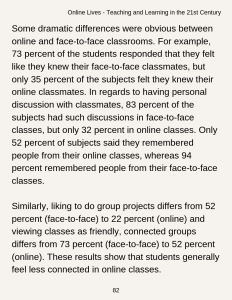15 Planning Your Writing – Quoting, Paraphrasing, and Summarizing

An important part of academic writing is incorporating evidence. To do this, you will need to know the basics of quoting, paraphrasing, and summarizing.
Making sure that you are using evidence properly, through quoting, paraphrasing, and summarizing, will ensure that you are giving necessary credit for other peoples’ words and ideas and will help you avoid plagiarism.
The table[1] below describes three different ways of using evidence:
| Quoting | Using the author’s exact words. Always cite it and use “quotation marks.” |
| Paraphrasing | Restating, in your own words, the author’s words or ideas without altering the meaning or providing interpretation. Paraphrases are about the same length as the original. Always cite it. |
| Summarizing | Condensing the author’s words or ideas without altering the meaning or providing interpretation—you use your own words for this. Basically, presenting the original information in a nutshell. Always cite it. |
Effectively quoting, paraphrasing, and summarizing always includes citation.
We’ll review some examples of how you can effectively incorporate evidence to support your ideas in the next section. Before we get there, make sure that you are familiar with the citation style and reference style that you are using for your assignment – these can be different for different courses and assignments.
The KPU Library has guides to help you with make sure that you are citing your work correctly, according to the style that your instructor wants you to use. Visit their page here.
If you have questions about how you should be citing evidence, ask your instructor or check with one of the KPU librarians.
Properly Summarizing and Paraphrasing[2]
When you summarize, you should write in your own words and the result should be substantially shorter than the original text. In addition, the sentence structure should be your original format. In other words, you should not take a sentence and replace core words with synonyms (different words with the same meaning).
You should also use your own words when you paraphrase. Paraphrasing should also involve your own sentence structure. However, paraphrasing might be as long or even longer than the original text. When you paraphrase, you should include, in your words, all the ideas from the original text in the same order as in the original text. You should not insert any of your ideas.
Both summaries and paraphrases should maintain the original author’s intent and perspective. Taking details out of context to suit your purposes is not ethical since it does not honor the original author’s ideas.
Review the examples in the table below to see the difference between quoting, paraphrasing, summarizing, and plagiarizing.
Here is a page from a book written by Maelle Jasper:

| Quoted Text | The study showed that personal discussions are much more likely to take place in face-to-face classes than in online classes since “83 percent of the subjects had such discussions in face-to-face classes, but only 32 percent in online classes” (Jasper, 2016, p. 82). |
| Paraphrased Text | Study results (Jasper, 2016, p. 82) show a clear difference between online and face-to-face classrooms. About twice as many students indicated they knew their classmates in face-to-face classes than in online classes. Students in face-to-face classes were about two-and-a-half times more likely to have discussions with classmates than were students in online classes. Students in face-to-face classes were about twice as likely to remember classmates as were students in online classes. Students in face-to-face classes viewed group projects as positive about two-and-a-half times more often than did students in online classes. Students in face-to-face classes saw class as a friendly place 73 percent of the time compared to 52 percent for online classes. Summing up these results, it is clear that students feel more connected in face-to-face classes than in online classes.
|
| Summarized Text | Students report a more personal connection to students in face-to-face classes than in online classes (Jasper, 2016, p.82). |
| Plagiarized Text | Some major differences were clear between Internet and in-person classrooms. For example, 73 percent of the study participants felt they were acquainted with their in-person classmates, but only 35 percent of the participants indicated they knew their distance classmates. |
In the example of plagiarized text, some of the words from the original text are replaced with synonyms (different words with the same meaning).
Below you can see how the words that are underlined in the original text have been replaced in the plagiarized text with synonyms (highlighted in yellow).
| Original Text | Some dramatic differences were obvious between online and face-to-face classrooms. For example, 73 percent of students responded that they felt like they knew their face-to-face classmates, but only 35 percent of the subjects said they remembered people from their online classes. |
| Plagiarized Text | Some major differences were clear between Internet and in-person classrooms. For example, 73 percent of the study participants felt they were acquainted with their in-person classmates, but only 35 percent of the participants indicated they knew their distance classmates. |
The only noticeable difference between the original text and the plagiarized text are the synonyms. This form of plagiarism is also known as “patch writing.” The original and the plagiarized text are identical, except for “patches” where synonyms have been used.
Patch writing[3]
You copy a short passage from an article you found. You change a couple of words, so that it’s different from the original. You carefully cite the source. It is still PLAGIARISM because even though you have acknowledged the source of the ideas with a citation, your new passage is too close to the original text. This form of plagiarism is called patch writing. In patch writing, the writer may delete a few words, change the order, substitute synonyms and even change the grammatical structure, but the reliance on the original text is still visible when the two are compared.
- "Quoting, Summarizing, and Paraphrasing in a Nutshell" by University of California Los Angeles Library CC BY 4.0 ↵
- Material in this section is reproduced and adapted from "Making Ethical and Effective Choices" by Saylor CC BY-NC-SA 3.0 ↵
- "Quoting, Paraphrasing, Summarizing & Patchwriting Quotations" by College of DuPage Library CC BY 4.0 ↵

